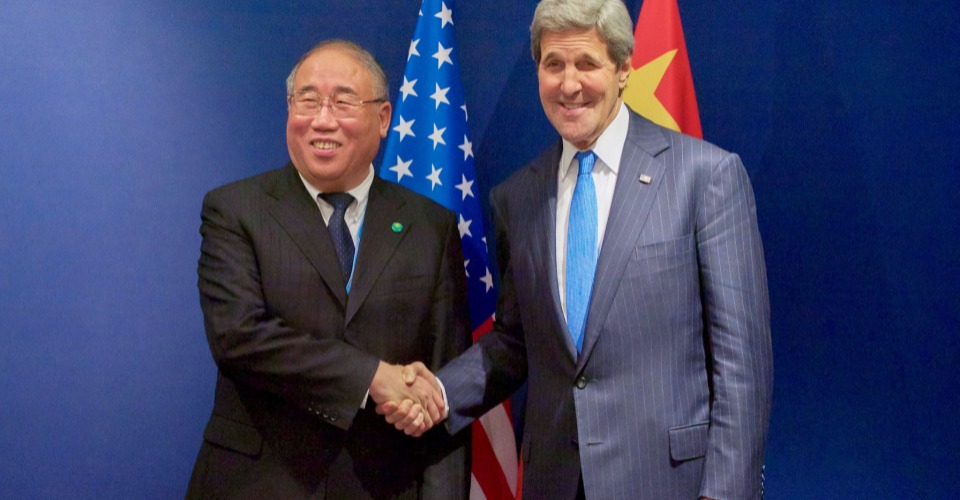
Two mid-week jolts shook the U.N. Climate Change Conference (COP26) in Glasgow, Scotland: A new dire warning about global warming, followed by a ray of hope from a pledge of greater cooperation between the U.S. and China, the world’s largest greenhouse gas emitters.
First came the alarm from a group of scientists and policymakers. Based on the current policies of every country, Climate Action Tracker (CAT) said, the Earth’s atmosphere will heat up by as much as 2.7°C by 2100. And even if every country fulfills its COP26 pledges to reduce emissions, the group said, the temperature rise would still be 2.4°C.
COP26 is risking a “massive credibility, action, and commitment gap” that casts a “long and dark shadow” on international efforts to reach net-zero greenhouse gas emissions (GHG) by mid-century, CAT said.
The CAT study explicitly called for much greater international action to avoid ecological and societal collapse. CAT based its projection on pledges countries covering 90% of the global economy have made to reduce their GHG emissions to net-zero by 2050, or in the case of China, by 2060, and India by 2070.
More importantly, the report looked at what countries pledged for reduction by 2030, known as the nationally determined contribution (NDC). Based on these goals, the 2050 targets are not attainable.
Not far enough or fast enough

Both forecasts are far above the 1.5°C mark scientists say is necessary to avoid catastrophic outcomes, a target adopted at the 2015 Paris Agreement. For many vulnerable countries, including island nations, a 2°C rise is a death sentence.
“There has been insufficient momentum from leaders and governments to increase 2030 climate targets ahead of, and at, Glasgow: NDC improvements submitted over the last year have reduced the emissions gap in 2030 by only 15-17%. The biggest absolute contributions to this narrowing come from China, E.U., and the U.S., though other countries with lower emissions levels have also improved their NDCs,” said CAT.
The organization did not hold back in its critiques of national governments:
“Contrary to the Paris Agreement’s requirement that each NDC update is a progression beyond the last, several governments have only resubmitted the same target as 2015 (Australia, Indonesia, Russia, Singapore, Switzerland, Thailand, Vietnam), or submitted an even less ambitious target (Brazil, Mexico). Some have not made new submissions at all (Turkey and Kazakhstan), and Iran has yet to ratify the Paris Agreement. Even with all new Glasgow pledges for 2030, we will emit roughly twice as much in 2030 as required for 1.5°. Therefore, all governments need to reconsider their targets.”
CAT’s research affirms another study by the scientists in a U.N. Framework Convention on Climate Change (UNCCC) issued in September, who termed the climate crisis a “code red” for humanity. Experts say the planet needs to cut at least 45% of its greenhouse gas emissions by 2030 to reach carbon neutrality by the mid-21st century.
As if that wasn’t enough of a wake-up call, a Washington Post study of national pledges showed a massive gap between what many countries report are their GHG emissions and what they actually emit. The total gap ranges between 8.5 billion to 13.3 billion tons of unreported GHG emissions per year, about 23% of the global total.
The gap is partly due to a lack of uniform standards in how countries report or don’t report emissions, the release of deliberately misleading figures, and how some countries calculate emissions vs. the ability of their ecosystems to absorb carbon emissions. The new reports only underscored international efforts to decarbonize have to be radically stepped up, especially to end the use of coal.
For the first time in the history of COP, the first draft of the Conference Final Document called for “phasing out coal and subsidies for fossil fuel.” Environmental activists celebrated the achievement, but several countries, along with the fossil fuel lobby, which has a more extensive presence in Glasgow than any country, contested the language.
As of press time, the latest draft indicates opponents of the phase-outs had scored some success. The most recent version of the Final Document calls on countries to accelerate the phase-out of “unabated coal power and inefficient subsidies for fossil fuels.” The qualifiers make all the difference, suggesting a move away from the unconditional demands fossil fuel-exporting countries and their companies have resisted.
U.S. climate envoy John Kerry said Washington backed the new wording. “We’re not talking about eliminating” coal, he told fellow diplomats. As for government funds flowing into fossil fuels, however, Kerry said: “Those subsidies have to go.” He acknowledged that the U.S. is “the largest oil and gas producer in the world and we have some of those subsidies.”
Despite the setback in negotiations around the Final Document, some 40 countries did sign an agreement to phase out coal, larger economies during the 2030s, and smaller ones during the 2040s. The U.S., China, and India, all among the biggest coal consumers, are not signers.
China-U.S. cooperation

But in a positive development, Xie Zhenhua, China’s climate change envoy, and Kerry appeared at a surprise press conference to announce a “Glasgow Declaration.” The agreement reflected the urgency of the moment and called for greater cooperation between the two countries and “enhance(d) ambitions” to reduce GHG emissions.
Both Xie and Kerry acknowledged the gap between the national plans submitted by the international community to Glasgow and what is needed to reduce emissions to limit temperature rise to 1.5°C.
U.S.–China cooperation is critical for meeting that goal. The U.S. is the largest emitter of GHG historically and presently emits more per person than any other country. China is the largest total emitter of GHG. Together, the two countries emit 40% of all GHG.
“We both see the challenge of climate change is existential and a severe one,” said Xie. “As two major powers in the world, China and the United States, we need to take our due responsibility and work together and work with others in the spirit of cooperation to address climate change.”
“Now the two largest economies in the world have agreed to raise climate ambition in this decisive decade,” said Kerry. “The United States and China have no shortage of differences. But on climate, cooperation is the only way to get this job done.”
China is the largest producer of energy from renewal sources in the world, about 32% of the total, and produces twice that of the U.S. Xie said China would begin a phase-out of coal when the new five-year economic development plan starts in 2026 and to a reduction of methane emissions.
“There is more agreement between China and the U.S. than divergence. We hope that this joint declaration can make a contribution to the success of COP26,” said Xie.










